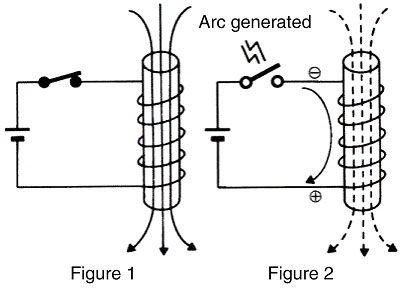What is counter-electromotive force (surge)?
Counter-electromotive force is the voltage that arises in the reverse direction when the switch is set to OFF with an inductive load using a coil. As shown in Figure 1, flux is generated when voltage is applied to the coil.
When the switch is set to OFF again, there is no more flux, but the coil's self-induction action causes counter-electromotive force to be generated in the direction where flux remains. A very high voltage is generated because the switch is already open and there is no place for the power arising from the coil to escape to.
Counter-electromotive force may cause contact wear and element damage. Use caution when using coil loads. As shown in Figure 2, both the power supply voltage and the counter-electromotive force will be applied to the open switch.
